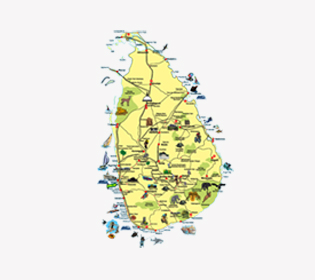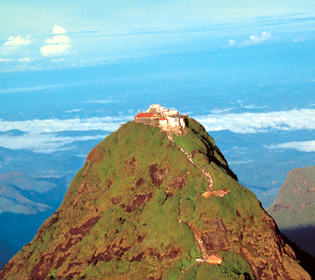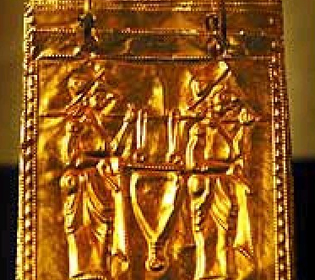
A flapping sea of black invades the emerald Minneriya Tank, as a flock of two thousand cormorants nosedive for fish. Later, elephants trudge by, drinking from the same reservoir.
You want to be present to witness it, and you can, a jeep safari from Deer Park Hotel takes you there in a jiffy.
Not nearly the largest tank in Sri Lanka, Minneriya Tank - with the woods that surround it forming the Minneriya-Giritale National Park - is nevertheless home to an extraordinary diversity of wildlife. If numbers interest you, there are nine species of amphibians, 24 species of mammals, 25 species of reptiles, 26 species of fish (three of which are endangered), 75 species of butterflies and 160 species of birds.
Making your way through the park, you will see elephants, Spotted Deer and also the Sambar, which is a deer with no spots and an apt scientific name, cerves unicolor. If you're lucky (or for some, unlucky), a leopard looking for food might cross your path. Other creatures you may not care to meet include the Sloth Bear, Indian Python and the Mugger Crocodile, also known as Tank Crocodile.
Less menacing but equally intriguing are the frogs and lizards with their tongues at the ready. Among the reptiles, the Red-lipped Lizard and skink are both endemic to Sri Lanka as well as endangered. The frogs, on the other hand, are more abundantly present and have a tendency to jump over your feet or across your eyes between leaves. A notable example with a formidable but misleading title is the Sri Lanka Greater Hourglass Tree Frog.
It all sounds like there’s such a lot to see at the park. But overhead is where the action really is. Sri Lanka, home to over 400 species of birds, has long been a birdwatcher’s paradise. In Minneriya National Park alone, 160 species crowd the trees or strut the banks.
You can afford to miss the Painted Storks, Great White Pelican, Gray Herons, and even the Ruddy Turnstones (whatever those are). But do try to spot the Sri Lanka Jungle Fowl, Sri Lanka Hanging Parrot, Sri Lanka Brown-capped Babbler and Sri Lanka Gray Hornbill, because, as you can guess from their names, nowhere else are you going to find them but here, in Sri Lanka.
Even if you’re not a bird enthusiast, at least you can boast about your trip later by throwing around some exotic bird-names.

Opened in 2002 just before the massive Wilpattu reopened, KAUDULLA NATIONAL PARK is Sri Lanka's newest national park, wildlife reserve and eco tourism attraction. Situated around the ancient Kaudulla tank, the national park provides a 6656 hectare elephant corridor, only 6 km from off the main Habarana - Trincomalee road.
With fantastic opportunities to see many elephants at close range, the park has become a popular destination for wildlife safaris that also take in leopards, sambar deer and the occasional sloth bear! As an additional novelty, you can go for cataraman rides on the tank.
Kaudulla National Park is Sri Lanka 's newest national park (opened in 2002) and is located off the main Habarana - Trincomalee road in the ancient cities' area (Cultural Triangle). The park has established a 6656-hectare elephant corridor between Somawathie Chaitiya and Minneriya National Parks . The best time to visit the park is between August and December.
The park is centred on ancient Kaudulla Tank (reservoir) and is home to up to 250 Elephants (including herds of juvenile males), Leopard, Fishing cat, Sloth bear, Sambar deer, and the endangered Rusty spotted cat.
Not too far from Deer Park Hotel, the Kaudulla National Park allows you to get close to the animals. Watch cats fish, and see if you can spot the endangered Rusty Spotted Cat. Migrating elephants pass through the park between August and December.

The biggest national park, whose Block 1 – one of the five areas open to public – has one of the world’s densest leopard populations. There are only 35 leopards residing here, but it’s probably the best place in the world to catch one, in the wild, on film. To see the entire park could take you at least three days, though there is a one-day jeep-trip available. The types of life you’ll encounter here are too numerous to list: better to see them for yourself.
Yala National Park is situated in the southeast region of the island in the dry zone boarding the Indian Ocean. Park area is belonging to two provinces namely South and Uva Provinces. The total area of the park (which is of 5 blocks) is 97,881 ha but only Block I and Block II are open for visitors.
Vegetation is mainly consists of Secondary lowland dry monsoon forest & semi arid thorny scrublands. Small patches of riverine forest The main dancing styles of Sri Lanka are Kandyan Dancing, Sbaragamuwa dancing, Pahatharata dancing & Wanni Dancing All the big game mammals of the country are found within the park. Elephant, Leopard, sloth bear, Spotted Dear, Wild Boar and sambhur. Apart from them small mammals such as Black naped hare, Grey, Ruddy & Striped necked mongoose, Grey Langur & porcupine are common small mammals.
Park is also famous for its abundant bird life. Over140 species have recorded so far within the park. Changeable Hawk Eagle, Crested serpent Eagle, Malabar pied Hornbill, Jungle fowl, painted Stork, White Ibis and Black necked Stork are commonly seen

Likened to an African game reserve, the Uda Walawe National Park is probably one of the most impressive nature parks in the country. About 106 miles southeast of Colombo, the park houses an estimated 500 elephants, of which you can see up to 100 at a time. The Uda Walawe Reservoir in the middle of the park serves the animals. Catch the Spotted Deer, Sambar, Water Buffalo, Mongoose, Bandicoot, Toque Monkey and Grey Langur in addition to foxes, crocodiles, wild boars, leopards and 30 varieties of snakes. If you dare - that is.

Bundala National Park is situated in the southeast part of the country in the semi arid zone. Park belongs to Southern Province. The park area is 6,216 hectares.The park was initially established as a Sanctuary in 1969. Due to its significant role as a wintering site for migratory birds this was declared as RAMSAR wetland in 1990.
Bundala National Park is mainly consist of 4 brackish lagoons, salt pans, marshes, thorny scrub lands, sand dunes, dry mixed ever green forests and dry grass lands. Park provides the shelter for Elephant, Spotted Dear, Wild Boar, Black naped hare, Grey & Ruddy mongoose, toque macaque, Grey Langur & porcupine, jackal and fishing & Rusty Spotted cats. This park is also well known for sightings of estuarine crocodile and mugger crocodile.
The main attraction of the Bundala is the birdlife, especially waders. There are both resident and migratory species. Greater Flamingo, Spot-billed Pelican, Lesser Adjutant and Black-necked Stork are among the large birds. Large flocks of terns, gulls, sand-pipers, snipes, teals, cormorants, egrets and many more water birds are commonly seen.

Located in south-west Sri Lanka, Sinharaja is the country's last viable area of primary tropical rainforest. More than 60% of the trees are endemic and many of them are considered rare. There is much endemic wildlife, especially birds, but the reserve is also home to over 50% of Sri Lanka's endemic species of mammals and butterflies, as well as many kinds of insects, reptiles and rare amphibians.
Sri Lanka's tropical rain forest, the Sinharaja is a UNESCO World Natural Heritage Site. One of the few virgin forests left in the world. Visitors are required to obtain permits from the Wildlife Department in order to visit this sanctuary. Streams, springs, rivers, waterfalls, leopard, monkeys, butterflies and moths, rare trees, valuable shrubs and medicinal herbs are all found within its green canopy. A trek along prescribed paths would provide nature lovers with a never to be forgotten experience of sights and sounds.

The only national park within the hill country, Horton Plains National Park – in which Sri Lanka’s second-tallest mountain stands - boasts some unusual highland vegetation. See if you can spot the Shaggy Bear-monkey, Sambhur, as you take a leisurely stroll to World's End. Bird watchers will be delighted to find the Orange-billed Babbler, Sri Lanka Blue Magpie, Sri Lanka Hill Munia, Dusky-blue Flycatcher, Pied Bush-Chat, Sri Lanka Whistling Thrush and Grey Tit.

Wilpattu is one of the oldest National Parks in Sri Lanka Located in Northwest coast lowland dry zone of Sri Lanka. The park lies within the North-central & North-western providences. The area of the park is 131693 ha. The unique feature of this park is the existence of “Willus” (Natural lakes)
The park consists of willus, dry-lowland forests, scrublands, open grasslands and coastal belt. Characteristic feature of the park is that majority of park area is covered with dense forest.
Elephants, leopards, sloth bear, water buffalo and spotted deer are among the large mammals. Coastal belt and willus support abundant birdlife such as painted storks, white ibis, open bills, Whistling teals, spoonbills, cormorants and kingfishers. Apart from them serpent eagles, great racket tail Drongo, Malabar pied hornbills, crested hawk eagles & Sri Lanka junglefowls are commonly seen. Both water monitors and mugger crocodiles can be seen in the willus.

Long before wildlife conservation became fashionable, Sri Lanka already had areas of jungle marked out for conservation. One such case is that of the Wasgamuwa National Park, a portion of which was declared a Strict Nature Reserve as early as 1938.
The park is about three hours from Deer Park Hotel by car, and if you think that’s too long a ride, you will change your mind when you actually set foot on it. Certainly there are the ubiquitous elephants (about 150 of these) and Spotted Deer, as well as the elusive leopard and Sloth Bear, both of which appear to have installed one resident representative in each national park. But it is the Sudu Kanda that truly captivates.

Situated in the west, the Gal Oya National Park is surrounded by Senanayake Samudra, the largest tank in the country. Take about and stalk close to the drinking elephants, which you can see in numbers of up to 150 at a time. Also great for bird watching.

KUMANA NATIONAL PARK is a well-known bird sanctuary where a multitude of birds breed and roost. One of the most significant features of the park is the ‘Kumana Villu’ - a 200 hectare natural swamp lake, fed by the ‘Kumbukkan Oya’ through a half mile long narrow channel. It is at this mangrove swamp that many water birds nest in May and June. Regular sightings include pelicans, painted storks, spoonbills, white ibis, herons, egrets and little cormorants. The very rare black-necked stork has also been spotted at the swamp. Besides the prolific birdlife, Kumana is also home to some of the mammals found in the larger YALA (West) park, such as elephants and leopards. The vegetation in Kumana consists mainly of mangrove trees, kumbuk trees and the karan fern, as well as the open marsh area.

Ten miles inland off the East Coast town of Pottuvil in an area that belonged to the ancient kingdom of Ruhuna are three a tanks, the Mahawewa, Kitulana and Sengamuwa. The most famous of the trio however is the Mahawewa, which is more famously known as Lahugala. This is in fact the name of the little village about a mile from the tanks. Lahugala a tanks is about 600 acres in extent, and had a storage capacity of 2760-acre feet and a 3700-ft. long bund. The history of Lahugala is lost in the mists of time, but it is almost certain that it dates back to the hay day of that historic realm. Brohier in his classic works statesa a | evidently served large and populous regions in ancient times"Lahugala and "a | was filled by channel that took off from an anicut thrown across the Heda Oya. Traces of this ancient channel, which was about 6 miles in length, are in evidence to this daya. The terrain around Lahugala is typically "dry zone", with secondary brush and forest. Between main road and Heda Oya however it is deeply forested, with giant trees, magnificent buttress roots and closely entwined undergrowth. The special vegetative feature in the Lahugala area is the beru (Oplismenus compostus). This tall succulent grass completely covers the three tanks and is a favorite among the elephants. While growing freely in this area, it is hardly encountered in large expanses in other parts of the island.



